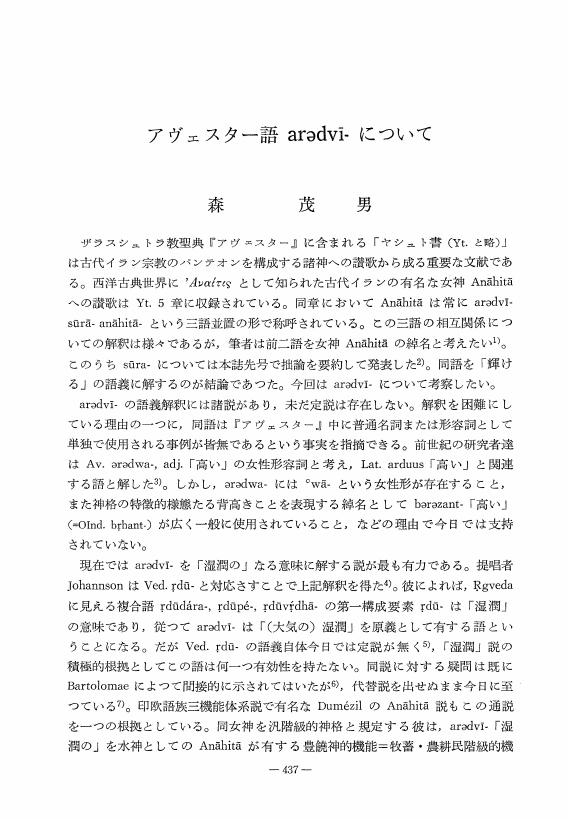1 0 0 0 OA 『習俗の始原をたずねて』法政大学出版局, 1992年, 334頁, 2,781円
- 著者
- 森 茂男
- 出版者
- 一般社団法人 日本オリエント学会
- 雑誌
- オリエント (ISSN:00305219)
- 巻号頁・発行日
- vol.36, no.1, pp.186-194, 1993-09-30 (Released:2010-03-12)
1 0 0 0 OA ビーストゥーン碑文の説話的構造
- 著者
- 森 茂男
- 出版者
- 一般社団法人 日本オリエント学会
- 雑誌
- オリエント (ISSN:00305219)
- 巻号頁・発行日
- vol.30, no.1, pp.108-122, 1987-09-30 (Released:2010-03-12)
As is known well, the theme of Bistun inscription is the justification of the kingship Darius I the Great obtained, but the structure upon which his narration is based seems, in spite of the importance, to have never been discussed sufficiently. It is, I consider, shown as the following chain of ‘motifemes’;‹Affirmative Situation I›: ‹Occurrence of Negative S.›: ‹Negative S.›: ‹Previous Anouncement›: ‹Battle›: ‹Affirmative S. II›.The structure is identified with that of epical tales found out frequently in the Shahnama of Firdausi, the theme of which is the change of kingships from a previous king to a new one (ex. Faridun, Ardasir, Manucihr and so on). This also means that the tale structure owened in common with some epical tales limits and constructs the narration of Bistun inscription. This conclusion may throw some light on the problem if Darius is a usurper or not.
1 0 0 0 OA アヴェスター語 aredvi- について
- 著者
- 森 茂男
- 出版者
- Japanese Association of Indian and Buddhist Studies
- 雑誌
- 印度學佛教學研究 (ISSN:00194344)
- 巻号頁・発行日
- vol.26, no.1, pp.437-432, 1977-12-31 (Released:2010-03-09)
1 0 0 0 OA イランの祭祀・信仰に関するデータベースの構築とペルシア文学論への発展的応用研究
- 著者
- 森 茂男 レザーイーバーグビィーディー ハサン 藤元 優子 竹原 新 藤元 優子 竹原 新 アーベディーシャール カームヤール
- 出版者
- 大阪大学
- 雑誌
- 基盤研究(B)
- 巻号頁・発行日
- 2007
本研究は、現代のイラン人が保持する伝統的な祭祀・信仰に関する資料をデータベース化することにより,これまで断片的にしか提示されてこなかった当分野の研究資料を一元化し、研究の効率を格段に向上させることを目指したものである。その結果、イラン国内でのイスラム以前の遺跡をはじめとする資料収集、データベース構築に係る作業、文学論への応用研究に係る研究活動を実施した。
1 0 0 0 『アヴェスター』ヤシュト書5, 11:13の解釈をめぐって
- 著者
- 森 茂男
- 出版者
- The Society for Near Eastern Studies in Japan
- 雑誌
- オリエント (ISSN:00305219)
- 巻号頁・発行日
- vol.20, no.1, pp.63-78,266, 1977
The Avesta Yašts, which constitute the earlist part of the Younger Avesta, comprises numerous uninteligible passages. Yašt 5, 11:13 are typical hymns having such passages.<br>Parallel passages are observed between Yt. 5, 11:13 and Yt. 10, 125 (a hymn to Mithra), that is to say, <i>ahmya vaše vaz_??_mna</i> (Yt. 5, 11) with <i>ahmya vaše vazante</i> (Yt. 10, 125), and <i>caθwaro vaštara spaeta vispa hama. gaona_??_ho</i> (Yt. 5, 13) with <i>caθwaro aurvanto spaeitita hama</i>. <i>gaona_??_ho</i> (Yt. 10, 125), although they have been rejected or ignored by many Iranists. The dual form, <i>hama</i>. <i>nafaeni berezanta taurvayanta</i>, (Yt. 5, 13), which shows the very contradictory grammatical feature in context, seems to be a formula in the non-Zoroastrian original Yašts. Therefore, the agents of the verb, <i>taurvayanta</i>, are not <i>caθwaro vaštara</i> "four drawing-animals, " but two gods suggested by the dual form. The above two evidences, I think, reveal the close relation between Anahita and Mithra. On the other hand, Anahita was also worshiped as the bestower and the guardian of kingship as well as Mithra in ancient Iran, and such function of Anahita is known by several passages in Yast 5, the inscriptions of Artaxerxes II and other evidences in West Iran. Moreover, considering the dual form of Yt. 5, 13 and Herodotus' famous misunderstanding about Iranian Aphrodite, Anahita (I, 131), we could not deny the possibility that both of them were united into a pair.<br>I suppose St. 11 sings a pair of gods, Mithra and Anahita, driving the chariot, and St. 13 comprises the fragments of two different hymns, one depicts Anahita's four drawing-animals, the other the combat against <i>daevas</i> by them. Yt. 5, 11: 13 would be the remnant of the lost hymns dedicated to Mithra-Anahita. If we accept Christensen's theory that, imitating the Avestan language, Median magi converted to Zoroastrianism composed Yašt 5, we may say that the original text of Yt. 5, 11:13 was the part of θεογουιη, so-called Median version of Yašts.<br>My translation of Yt. 5, 11:13 is as follows;<br>St. 11: Who (the male god, i. e., Mithra), the first, drives the chariot, gripes the bridles for (driving) the chariot; (Anahita) driving his chariot, …<br>St. 13: Whose four drawing-animals (are), white ones, all of one colour. (Two gods, Mithra and Anahita) of the same family, high ones, overwhlmed…

